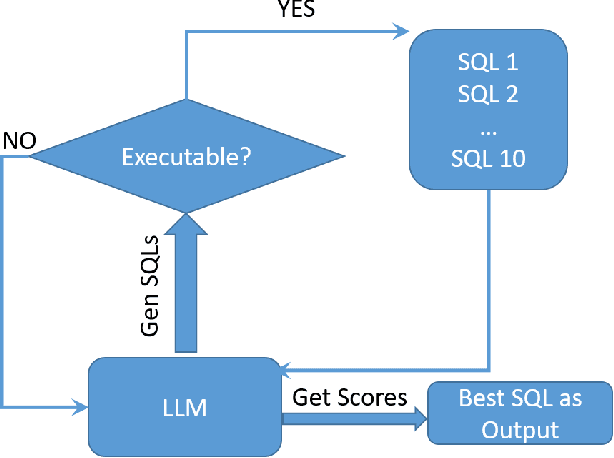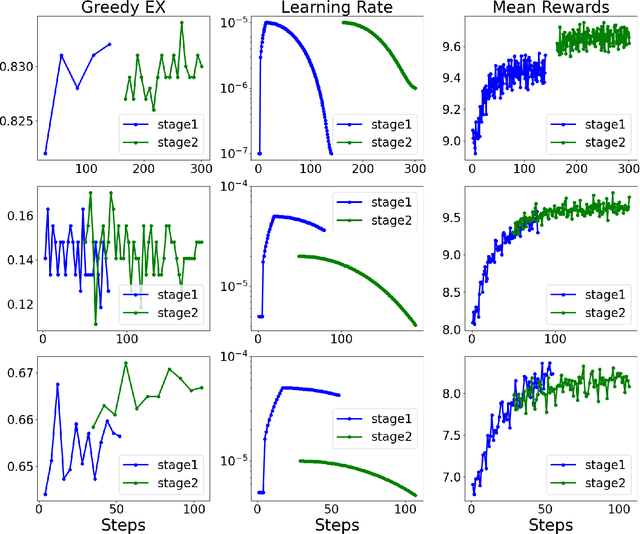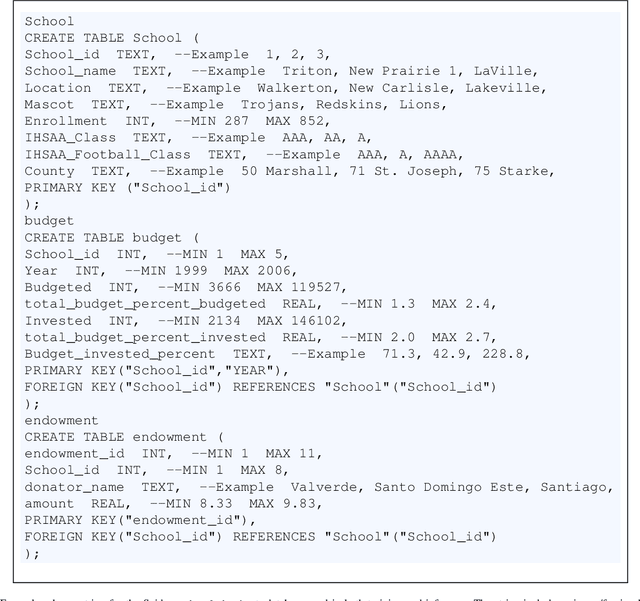Text To Sql
Text-to-SQL (or Text2SQL) is the task of translating natural language questions into SQL queries to retrieve information from or execute other tasks in relational databases. Text-to-SQL can also be abbreviated as NL2SQL.
Papers and Code
SQLSpace: A Representation Space for Text-to-SQL to Discover and Mitigate Robustness Gaps
Oct 31, 2025We introduce SQLSpace, a human-interpretable, generalizable, compact representation for text-to-SQL examples derived with minimal human intervention. We demonstrate the utility of these representations in evaluation with three use cases: (i) closely comparing and contrasting the composition of popular text-to-SQL benchmarks to identify unique dimensions of examples they evaluate, (ii) understanding model performance at a granular level beyond overall accuracy scores, and (iii) improving model performance through targeted query rewriting based on learned correctness estimation. We show that SQLSpace enables analysis that would be difficult with raw examples alone: it reveals compositional differences between benchmarks, exposes performance patterns obscured by accuracy alone, and supports modeling of query success.
Rethinking Text-to-SQL: Dynamic Multi-turn SQL Interaction for Real-world Database Exploration
Oct 30, 2025Recent advances in Text-to-SQL have achieved strong results in static, single-turn tasks, where models generate SQL queries from natural language questions. However, these systems fall short in real-world interactive scenarios, where user intents evolve and queries must be refined over multiple turns. In applications such as finance and business analytics, users iteratively adjust query constraints or dimensions based on intermediate results. To evaluate such dynamic capabilities, we introduce DySQL-Bench, a benchmark assessing model performance under evolving user interactions. Unlike previous manually curated datasets, DySQL-Bench is built through an automated two-stage pipeline of task synthesis and verification. Structured tree representations derived from raw database tables guide LLM-based task generation, followed by interaction-oriented filtering and expert validation. Human evaluation confirms 100% correctness of the synthesized data. We further propose a multi-turn evaluation framework simulating realistic interactions among an LLM-simulated user, the model under test, and an executable database. The model must adapt its reasoning and SQL generation as user intents change. DySQL-Bench covers 13 domains across BIRD and Spider 2 databases, totaling 1,072 tasks. Even GPT-4o attains only 58.34% overall accuracy and 23.81% on the Pass@5 metric, underscoring the benchmark's difficulty. All code and data are released at https://github.com/Aurora-slz/Real-World-SQL-Bench .
From Queries to Insights: Agentic LLM Pipelines for Spatio-Temporal Text-to-SQL
Oct 29, 2025Natural-language-to-SQL (NL-to-SQL) systems hold promise for democratizing access to structured data, allowing users to query databases without learning SQL. Yet existing systems struggle with realistic spatio-temporal queries, where success requires aligning vague user phrasing with schema-specific categories, handling temporal reasoning, and choosing appropriate outputs. We present an agentic pipeline that extends a naive text-to-SQL baseline (llama-3-sqlcoder-8b) with orchestration by a Mistral-based ReAct agent. The agent can plan, decompose, and adapt queries through schema inspection, SQL generation, execution, and visualization tools. We evaluate on 35 natural-language queries over the NYC and Tokyo check-in dataset, covering spatial, temporal, and multi-dataset reasoning. The agent achieves substantially higher accuracy than the naive baseline 91.4% vs. 28.6% and enhances usability through maps, plots, and structured natural-language summaries. Crucially, our design enables more natural human-database interaction, supporting users who lack SQL expertise, detailed schema knowledge, or prompting skill. We conclude that agentic orchestration, rather than stronger SQL generators alone, is a promising foundation for interactive geospatial assistants.
Rethinking Schema Linking: A Context-Aware Bidirectional Retrieval Approach for Text-to-SQL
Oct 16, 2025Schema linking -- the process of aligning natural language questions with database schema elements -- is a critical yet underexplored component of Text-to-SQL systems. While recent methods have focused primarily on improving SQL generation, they often neglect the retrieval of relevant schema elements, which can lead to hallucinations and execution failures. In this work, we propose a context-aware bidirectional schema retrieval framework that treats schema linking as a standalone problem. Our approach combines two complementary strategies: table-first retrieval followed by column selection, and column-first retrieval followed by table selection. It is further augmented with techniques such as question decomposition, keyword extraction, and keyphrase extraction. Through comprehensive evaluations on challenging benchmarks such as BIRD and Spider, we demonstrate that our method significantly improves schema recall while reducing false positives. Moreover, SQL generation using our retrieved schema consistently outperforms full-schema baselines and closely approaches oracle performance, all without requiring query refinement. Notably, our method narrows the performance gap between full and perfect schema settings by 50\%. Our findings highlight schema linking as a powerful lever for enhancing Text-to-SQL accuracy and efficiency.
FinAI Data Assistant: LLM-based Financial Database Query Processing with the OpenAI Function Calling API
Oct 15, 2025We present FinAI Data Assistant, a practical approach for natural-language querying over financial databases that combines large language models (LLMs) with the OpenAI Function Calling API. Rather than synthesizing complete SQL via text-to-SQL, our system routes user requests to a small library of vetted, parameterized queries, trading generative flexibility for reliability, low latency, and cost efficiency. We empirically study three questions: (RQ1) whether LLMs alone can reliably recall or extrapolate time-dependent financial data without external retrieval; (RQ2) how well LLMs map company names to stock ticker symbols; and (RQ3) whether function calling outperforms text-to-SQL for end-to-end database query processing. Across controlled experiments on prices and fundamentals, LLM-only predictions exhibit non-negligible error and show look-ahead bias primarily for stock prices relative to model knowledge cutoffs. Ticker-mapping accuracy is near-perfect for NASDAQ-100 constituents and high for S\&P~500 firms. Finally, FinAI Data Assistant achieves lower latency and cost and higher reliability than a text-to-SQL baseline on our task suite. We discuss design trade-offs, limitations, and avenues for deployment.
Agent Bain vs. Agent McKinsey: A New Text-to-SQL Benchmark for the Business Domain
Oct 08, 2025In the business domain, where data-driven decision making is crucial, text-to-SQL is fundamental for easy natural language access to structured data. While recent LLMs have achieved strong performance in code generation, existing text-to-SQL benchmarks remain focused on factual retrieval of past records. We introduce CORGI, a new benchmark specifically designed for real-world business contexts. CORGI is composed of synthetic databases inspired by enterprises such as Doordash, Airbnb, and Lululemon. It provides questions across four increasingly complex categories of business queries: descriptive, explanatory, predictive, and recommendational. This challenge calls for causal reasoning, temporal forecasting, and strategic recommendation, reflecting multi-level and multi-step agentic intelligence. We find that LLM performance drops on high-level questions, struggling to make accurate predictions and offer actionable plans. Based on execution success rate, the CORGI benchmark is about 21\% more difficult than the BIRD benchmark. This highlights the gap between popular LLMs and the need for real-world business intelligence. We release a public dataset and evaluation framework, and a website for public submissions.
Do LLMs Align with My Task? Evaluating Text-to-SQL via Dataset Alignment
Oct 06, 2025



Supervised Fine-Tuning (SFT) is an effective method for adapting Large Language Models (LLMs) on downstream tasks. However, variability in training data can hinder a model's ability to generalize across domains. This paper studies the problem of dataset alignment for Natural Language to SQL (NL2SQL or text to SQL), examining how well SFT training data matches the structural characteristics of target queries and how this alignment impacts model performance. We hypothesize that alignment can be accurately estimated by comparing the distributions of structural SQL features across the training set, target data, and the model's predictions prior to SFT. Through comprehensive experiments on three large cross-domain NL2SQL benchmarks and multiple model families, we show that structural alignment is a strong predictor of fine-tuning success. When alignment is high, SFT yields substantial gains in accuracy and SQL generation quality; when alignment is low, improvements are marginal or absent. These findings highlight the importance of alignment-aware data selection for effective fine-tuning and generalization in NL2SQL tasks.
FINCH: Financial Intelligence using Natural language for Contextualized SQL Handling
Oct 02, 2025Text-to-SQL, the task of translating natural language questions into SQL queries, has long been a central challenge in NLP. While progress has been significant, applying it to the financial domain remains especially difficult due to complex schema, domain-specific terminology, and high stakes of error. Despite this, there is no dedicated large-scale financial dataset to advance research, creating a critical gap. To address this, we introduce a curated financial dataset (FINCH) comprising 292 tables and 75,725 natural language-SQL pairs, enabling both fine-tuning and rigorous evaluation. Building on this resource, we benchmark reasoning models and language models of varying scales, providing a systematic analysis of their strengths and limitations in financial Text-to-SQL tasks. Finally, we propose a finance-oriented evaluation metric (FINCH Score) that captures nuances overlooked by existing measures, offering a more faithful assessment of model performance.
PaVeRL-SQL: Text-to-SQL via Partial-Match Rewards and Verbal Reinforcement Learning
Sep 08, 2025



Text-to-SQL models allow users to interact with a database more easily by generating executable SQL statements from natural-language questions. Despite recent successes on simpler databases and questions, current Text-to-SQL methods still suffer from low execution accuracy on industry-scale databases and complex questions involving domain-specific business logic. We present \emph{PaVeRL-SQL}, a framework that combines \emph{Partial-Match Rewards} and \emph{Verbal Reinforcement Learning} to drive self-improvement in reasoning language models (RLMs) for Text-to-SQL. To handle practical use cases, we adopt two pipelines: (1) a newly designed in-context learning framework with group self-evaluation (verbal-RL), using capable open- and closed-source large language models (LLMs) as backbones; and (2) a chain-of-thought (CoT) RL pipeline with a small backbone model (OmniSQL-7B) trained with a specially designed reward function and two-stage RL. These pipelines achieve state-of-the-art (SOTA) results on popular Text-to-SQL benchmarks -- Spider, Spider 2.0, and BIRD. For the industrial-level Spider2.0-SQLite benchmark, the verbal-RL pipeline achieves an execution accuracy 7.4\% higher than SOTA, and the CoT pipeline is 1.4\% higher. RL training with mixed SQL dialects yields strong, threefold gains, particularly for dialects with limited training data. Overall, \emph{PaVeRL-SQL} delivers reliable, SOTA Text-to-SQL under realistic industrial constraints. The code is available at https://github.com/PaVeRL-SQL/PaVeRL-SQL.
SPFT-SQL: Enhancing Large Language Model for Text-to-SQL Parsing by Self-Play Fine-Tuning
Sep 04, 2025Despite the significant advancements of self-play fine-tuning (SPIN), which can transform a weak large language model (LLM) into a strong one through competitive interactions between models of varying capabilities, it still faces challenges in the Text-to-SQL task. SPIN does not generate new information, and the large number of correct SQL queries produced by the opponent model during self-play reduces the main model's ability to generate accurate SQL queries. To address this challenge, we propose a new self-play fine-tuning method tailored for the Text-to-SQL task, called SPFT-SQL. Prior to self-play, we introduce a verification-based iterative fine-tuning approach, which synthesizes high-quality fine-tuning data iteratively based on the database schema and validation feedback to enhance model performance, while building a model base with varying capabilities. During the self-play fine-tuning phase, we propose an error-driven loss method that incentivizes incorrect outputs from the opponent model, enabling the main model to distinguish between correct SQL and erroneous SQL generated by the opponent model, thereby improving its ability to generate correct SQL. Extensive experiments and in-depth analyses on six open-source LLMs and five widely used benchmarks demonstrate that our approach outperforms existing state-of-the-art (SOTA) methods.
 Add to Chrome
Add to Chrome Add to Firefox
Add to Firefox Add to Edge
Add to Edge